语言学概论第十章Language Acquisition
- 格式:ppt
- 大小:1.07 MB
- 文档页数:45
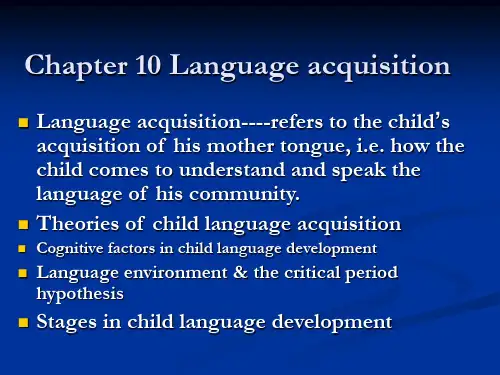
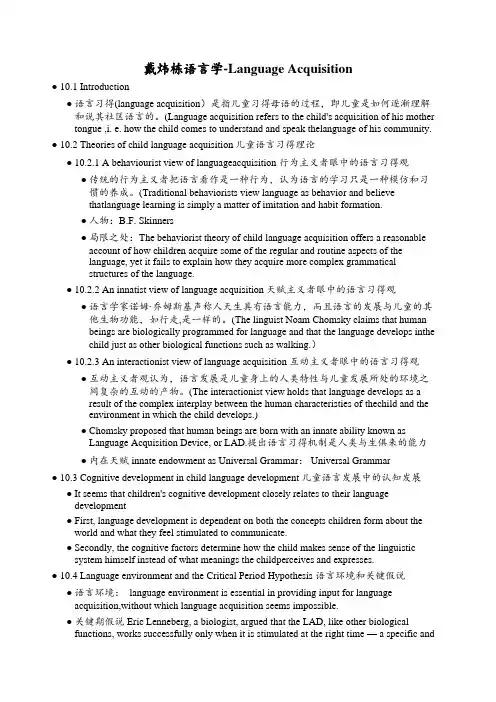
戴炜栋语言学-Language Acquisition●10.1 Introduction●语言习得(language acquisition)是指儿童习得母语的过程,即儿童是如何逐渐理解和说其社区语言的。
(Language acquisition refers to the child's acquisition of his mother tongue ,i. e. how the child comes to understand and speak thelanguage of his community.●10.2 Theories of child language acquisition儿童语言习得理论●10.2.1 A behaviourist view of languageacquisition 行为主义者眼中的语言习得观●传统的行为主义者把语言看作是一种行为,认为语言的学习只是一种模仿和习惯的养成。
(Traditional behaviorists view language as behavior and believethatlanguage learning is simply a matter of imitation and habit formation.●人物:B.F. Skinners●局限之处:The behaviorist theory of child language acquisition offers a reasonableaccount of how children acquire some of the regular and routine aspects of thelanguage, yet it fails to explain how they acquire more complex grammaticalstructures of the language.●10.2.2 An innatist view of language acquisition天赋主义者眼中的语言习得观●语言学家诺姆·乔姆斯基声称人天生具有语言能力,而且语言的发展与儿童的其他生物功能,如行走,是一样的。


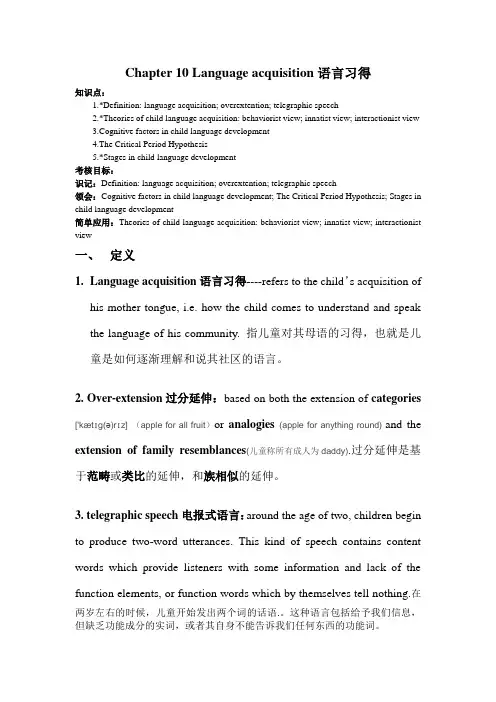
Chapter 10 Language acquisition语言习得知识点:1.*Definition: language acquisition; overextention; telegraphic speech2.*Theories of child language acquisition: behaviorist view; innatist view; interactionist view3.Cognitive factors in child language development4.The Critical Period Hypothesis5.*Stages in child language development考核目标:识记:Definition: language acquisition; overextention; telegraphic speech领会:Cognitive factors in child language development; The Critical Period Hypothesis; Stages in child language development简单应用:Theories of child language acquisition: behaviorist view; innatist view; interactionist view一、定义nguage acquisition语言习得----refers to the child’s acquisition ofhis mother tongue, i.e. how the child comes to understand and speak the language of his community. 指儿童对其母语的习得,也就是儿童是如何逐渐理解和说其社区的语言。
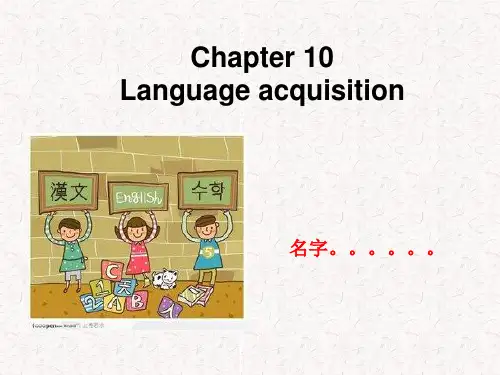
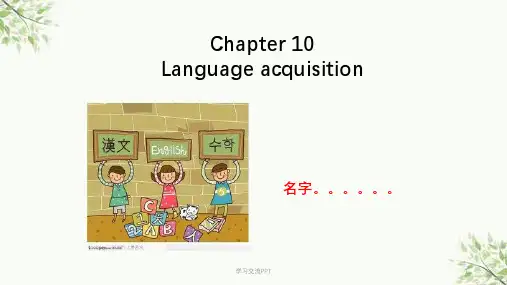
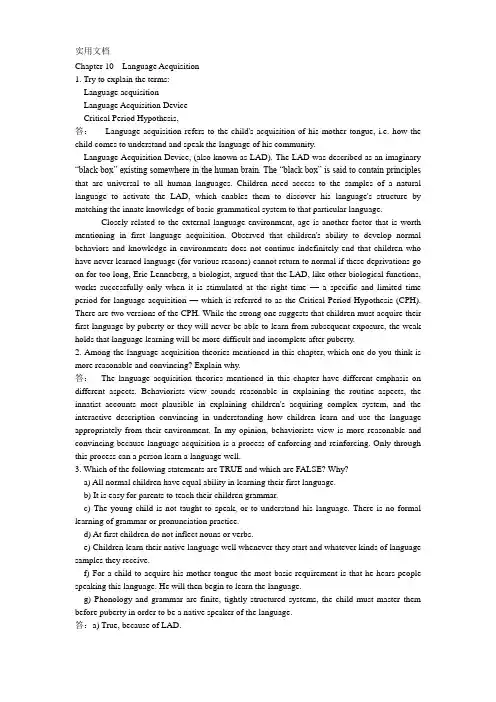
Chapter 10 Language Acquisition1. Try to explain the terms:Language acquisitionLanguage Acquisition DeviceCritical Period Hypothesis,答:Language acquisition refers to the child's acquisition of his mother tongue, i.e. how the child comes to understand and speak the language of his community.Language Acquisition Device, (also known as LAD). The LAD was described as an imaginary “black box” existing somewhere in the human brain. The “black box” is said to contain principles that are universal to all human languages. Children need access to the samples of a natural language to activate the LAD, which enables them to discover his language's structure by matching the innate knowledge of basic grammatical system to that particular language.Closely related to the external language environment, age is another factor that is worth mentioning in first language acquisition. Observed that children's ability to develop normal behaviors and knowledge in environments does not continue indefinitely end that children who have never learned language (for various reasons) cannot return to normal if these deprivations go on for too long, Eric Lenneberg, a biologist, argued that the LAD, like other biological functions, works successfully only when it is stimulated at the right time ––a specific and limited time period for language acquisition –– which is referred to as the Critical Period Hypothesis (CPH). There are two versions of the CPH. While the strong one suggests that children must acquire their first language by puberty or they will never be able to learn from subsequent exposure, the weak holds that language learning will be more difficult and incomplete after puberty.2. Among the language acquisition theories mentioned in this chapter, which one do you think is more reasonable and convincing? Explain why.答:The language acquisition theories mentioned in this chapter have different emphasis on different aspects. Behaviorists view sounds reasonable in explaining the routine aspects, the innatist accounts most plausible in explaining children's acquiring complex system, and the interactive description convincing in understanding how children learn and use the language appropriately from their environment. In my opinion, behaviorists view is more reasonable and convincing because language acquisition is a process of enforcing and reinforcing. Only through this process can a person learn a language well.3. Which of the following statements are TRUE and which are FALSE? Why?a) All normal children have equal ability in learning their first language.b) It is easy for parents to teach their children grammar.c) The young child is not taught to speak, or to understand his language. There is no formal learning of grammar or pronunciation practice.d) At first children do not inflect nouns or verbs.e) Children learn their native language well whenever they start and whatever kinds of language samples they receive.f) For a child to acquire his mother tongue the most basic requirement is that he hears people speaking this language. He will then begin to learn the language.g) Phonology and grammar are finite, tightly structured systems, the child must master them before puberty in order to be a native speaker of the language.答:a) True, because of LAD.b) False, because children's grammatical development is gradual and some subtle grammatical distinctions may not be mastered much before the age of ten.c) True, because his language is acquired.d) True, because at the very beginning, children's language is totally about content.e) False, because of CPH.f) True, because when a child acquires his native language he needs language environment.g) True, because of CPH.4. Each of the following utterances comes from the speech of a child in the two-word state. Identify the semantic relation expressed by each of these utterancesIntended meaning Child’s utterancea) Jimmy is swimming? Jimmy swimb) Ken’s book Ken bookc) Daddy is at his office. Daddy officed) You push the babies. Push babye) Mommy is reading. Mommy read答:(略)Chapter 11 Second Language Acquisition1. To what extent is second language learning similar to first language learning? Can you list some proof from your own learning experiences?答:(1) From a theoretical point of view, the new findings and advances in first language acquisition especially in learning theories and learning process are illuminating in understanding second language acquisition. The techniques used to collect and analyze date in first language acquisition also provide insights and perspectives in the study of second language acquisition. For example, we started to learn our native language from listening, and then speaking.(2) (略)2. Try to observe yourself and pay attention to your own learning experience, what conclusions can you reach about the role of Chinese in your English learning? On what occasions are you more likely to use or depend on Chinese in learning or using English?答:(略)3. Identify the errors in the following sentences and trace the possible cause for each error.a) Please do not hinder my work.b) –– Would you mind lending me your tape-recorder?–– Yes, certainly.c) During the meeting we discussed about the research project.d) Alison is in poor health. She is easy to catch cold.e) Tile light can impress the film and in this way to fix the image of the film.f) The scenery is too beautiful to describe it.答:a) Please do not hinder me in my work.(negative transfer)b) –– Would you mind lending me your tape-recorder?–– No, I don't.(negative transfer)c) During the meeting we discussed the research project.(overgeneralization)d) Alison is in poor health. She catches cold easily.(overgeneralization)e) The light can impress the film and in this way can fix the image of the film.(negative transfer)f) The scenery is too beautiful to describe.(cross-association)4. Based on your own experience, give at least three examples which are related to overgeneralization and performance errors.答:Overgeneralization: * I losed the game.* There are ten sheeps.* I was devoted to do this job.5. What kind of a language learner you are? Have you ever thought of why and how you learn English?答:(略)6. List the learning strategies you use frequently, and then compare that with the strategy listed in 11. 8.答:(略)7. Identify personality factors that may contribute to the success of learning a second/foreign language.答:The personality traits such as extroversion, talkativeness, self-esteem, self-confidence may contribute to the success of learning a second/foreign language.。

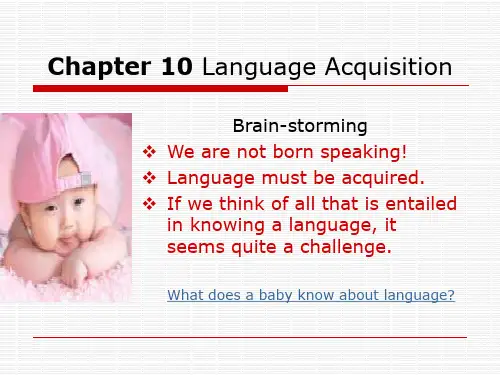
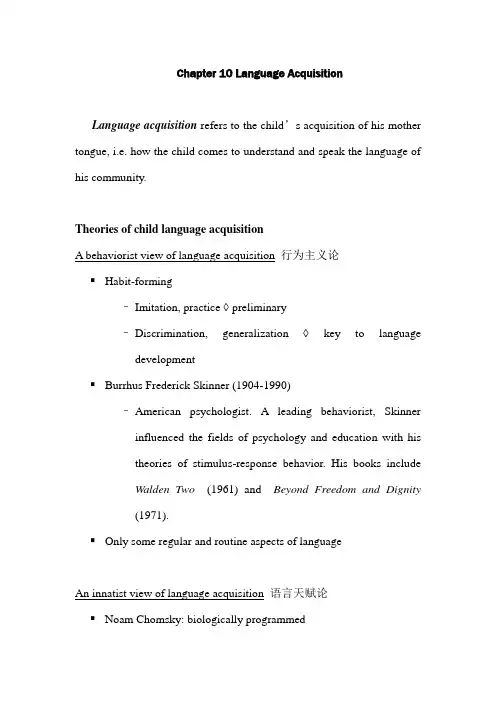
Chapter 10 Language AcquisitionLanguage acquisition refers to the child’s acquisition of his mother tongue, i.e. how the child comes to understand and speak the language of his community.Theories of child language acquisitionA behaviorist view of language acquisition 行为主义论▪Habit-forming–Imitation, practice ◊ preliminary–Discrimination, generalization ◊key to language development▪Burrhus Frederick Skinner (1904-1990)–American psychologist. A leading behaviorist, Skinner influenced the fields of psychology and education with histheories of stimulus-response behavior. His books includeWalden Two(1961) and Beyond Freedom and Dignity(1971).▪Only some regular and routine aspects of languageAn innatist view of language acquisition 语言天赋论▪Noam Chomsky: biologically programmed▪Language Acquisition Device ◊ LAD–Principles be activated by the access to natural language samples ◊ Universal Grammar (UG)–One language: particular use of the principles▪Logical problem:–children can discover the underlying rules with confusing information and without guidance and correction–An interactionist view of language acquisition 身心交感论▪The complex interplay between the human characteristics of the child and environment in which the child develops.▪Special speech: motherese, child directed speech, caretaker talk.▪Comprehensible language samples: right level conversation can facilitate FLA▪In addition to the “motherese”or “caretaker talk”, parents provide children with direct linguistic training by correcting ill-formed utterances, i.e. to offer “feedback”and “recasts”.▪Such recasts provide the children with potentially useful information –adding a missing verb, changing the form of a pronoun and so on.语言习得语言学中指儿童如何掌握本族语的过程。
Chapter 10 Language Acquisition 语言习得1.First language acquisition 第一语言习得a)The biological basis of language acquisition 语言习得的生物基础Language acquisition is a genetically determined capacity that all humans are endowed with. Human is biologically programmed to acquire at least one language.Any child who is capable of acquiring some particular human language is capable of acquiring any human language spontaneously and effortlessly.语言习得是全人类均具备的通过遗传而得来的能力。
人生来就具备一种天赋,或一种生物机制,使他们至少能习得一种语言。
儿童只要能习得某种人类语言,它就能本能而轻松地习得任何人类语言。
b)Language acquisition as the acquisition of grammatical rules 语言习得即语法规则的习得Language acquisition is primarily the acquisition of the grammatical system of language. It doesn’t mean that every specific rule allowed by the grammatical system of a language must be acquired. What is actually acquired by young children are some general principle that are fundamental to the grammaticality of speech.语言习得主要是语言的语法体系的习得。
Chapter 10 Language acquisition语言习得知识点:1.*Definition: language acquisition; overextention; telegraphic speech2.*Theories of child language acquisition: behaviorist view; innatist view; interactionist view3.Cognitive factors in child language development4.The Critical Period Hypothesis5.*Stages in child language development考核目标:识记:Definition: language acquisition; overextention; telegraphic speech领会:Cognitive factors in child language development; The Critical Period Hypothesis; Stages in child language development简单应用:Theories of child language acquisition: behaviorist view; innatist view; interactionist view一、定义nguage acquisition语言习得----refers to the child’s acquisition ofhis mother tongue, i.e. how the child comes to understand and speak the language of his community. 指儿童对其母语的习得,也就是儿童是如何逐渐理解和说其社区的语言。
Chapter 10 Language Acquisition 语言习得1.First language acquisition 第一语言习得a)The biological basis of language acquisition 语言习得的生物基础Language acquisition is a genetically determined capacity that all humans are endowed with. Human is biologically programmed to acquire at least one language.Any child who is capable of acquiring some particular human language is capable of acquiring any human language spontaneously and effortlessly.语言习得是全人类均具备的通过遗传而得来的能力。
人生来就具备一种天赋,或一种生物机制,使他们至少能习得一种语言。
儿童只要能习得某种人类语言,它就能本能而轻松地习得任何人类语言。
b)Language acquisition as the acquisition of grammatical rules 语言习得即语法规则的习得Language acquisition is primarily the acquisition of the grammatical system of language. It doesn’t mean that every specific rule allowed by the grammatical system of a language must be acquired. What is actually acquired by young children are some general principle that are fundamental to the grammaticality of speech.语言习得主要是语言的语法体系的习得。